vision quiz
1/65
There's no tags or description
Looks like no tags are added yet.
Name | Mastery | Learn | Test | Matching | Spaced |
|---|
No study sessions yet.
66 Terms
sensations
The process by which sensory receptors (like in the eyes, ears, skin) detect physical energy from the environment and send it to the brain.
Example: Light waves entering your eyes and being detected by rods and cones.
perceptions
The process by which the brain organizes and interprets sensory information, giving it meaning.
Example: Seeing light waves and recognizing them as your friend’s face.
The McGurk Effect
A perceptual illusion where what you see affects what you hear.
Example: You hear “ba,” but if you watch a person’s lips moving as if saying “fa,” your brain may “hear” “fa” instead—because your brain combines visual and auditory information.
psychophysics
The study of the relationship between physical stimuli and how we psychologically experience them.
Example: Studying how loud a sound must be before people notice it.
absolute threshold
The minimum amount of stimulation needed to detect a stimulus 50% of the time.
Example: Hearing a clock tick from 20 feet away in a quiet room.
difference threshold
The smallest change in a stimulus that you can notice 50% of the time.
Example: Noticing when someone slowly increases the volume of music.
bottom up processing
Using raw sensory data to build up perceptions—seeing details first.
Example: Seeing a painting and noticing colors, shapes, lines, before recognizing it as a face.
top down processing
Using prior knowledge, expectations, or context to interpret sensations.
Example: Reading messy handwriting but still understanding it because you know the sentence.
weber freghner law
A principle that says the bigger the original stimulus, the greater the change needed to detect a difference.
Example: You’ll notice adding 1 pound to a 5-pound weight, but not to a 50-pound weight.
sensation thresholds
General term referring to the levels at which we detect stimuli, including absolute threshold and difference threshold.
weber’s law
Part of Weber–Fechner: The JND is a constant proportion of the original stimulus.
Example: If you need a 10% change to notice a difference, you will notice 1 lb added to 10 lbs, but need 10 lbs added to 100 lbs.
sensory adaption
A decrease in sensitivity to a constant, unchanging stimulus.
Example: Not noticing the strong smell of perfume after a few minutes.
transduction
The process where sensory receptors convert physical energy into electrical brain signals.
Example: In the eye, rods and cones convert light into neural impulses.
receptors
Specialized cells that detect sensory information like light, sound, pressure, or chemicals.
Example: Rods and cones in the eye, taste buds on the tongue.
sensory pathway
The route that sensory information takes from receptors to the brain (receptors → nerves → brain regions).
Example: Retina → optic nerve → thalamus → visual cortex.
retina
The back surface of the eye that contains sensory receptor cells (rods and cones) that detect light and start transduction.
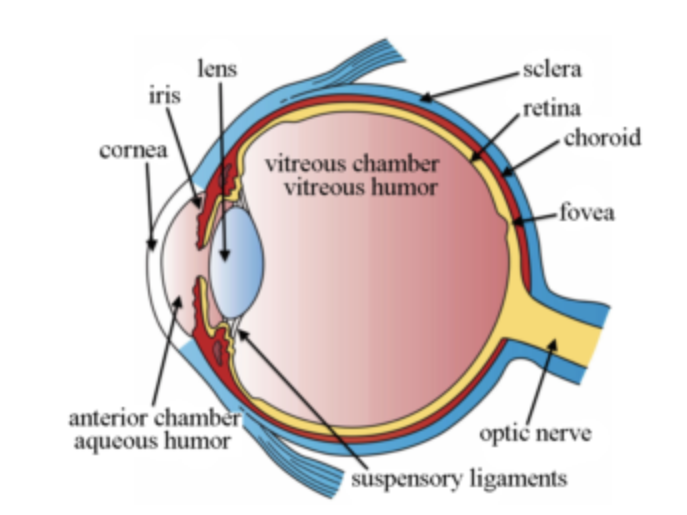
optic nerve
The nerve that carries visual information from the retina to the brain.
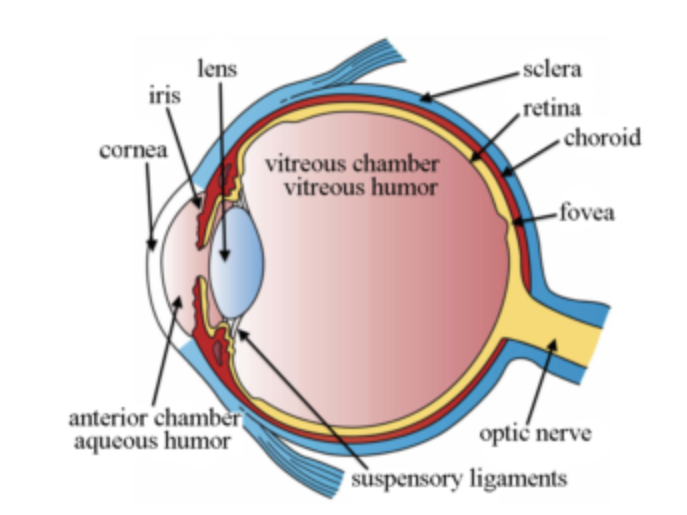
optic disc/blindspot
The spot on the retina where the optic nerve leaves, so there are no rods or cones, meaning no vision in that spot.

fovea
The center of the retina with the highest concentration of cones, responsible for sharp, detailed vision.
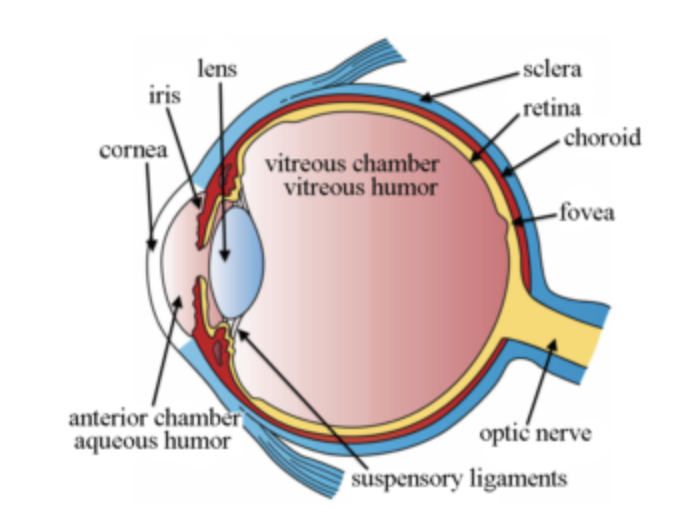
cornea
The clear outer covering of the eye that protects it and begins focusing light.
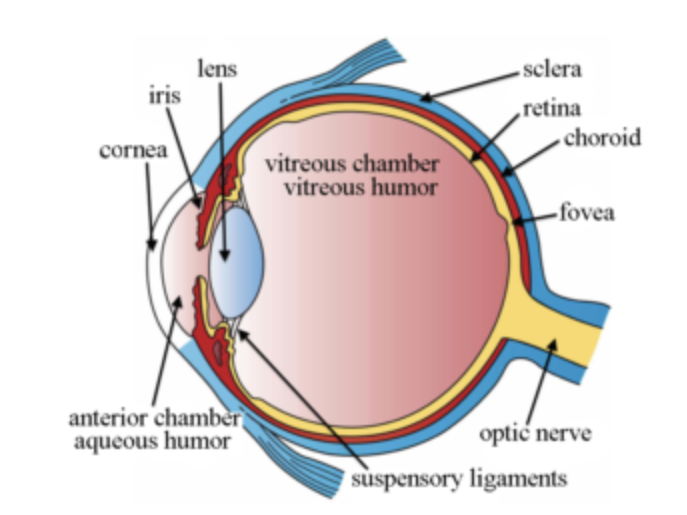
pupil
The opening in the eye that lets light in. It changes size depending on light.
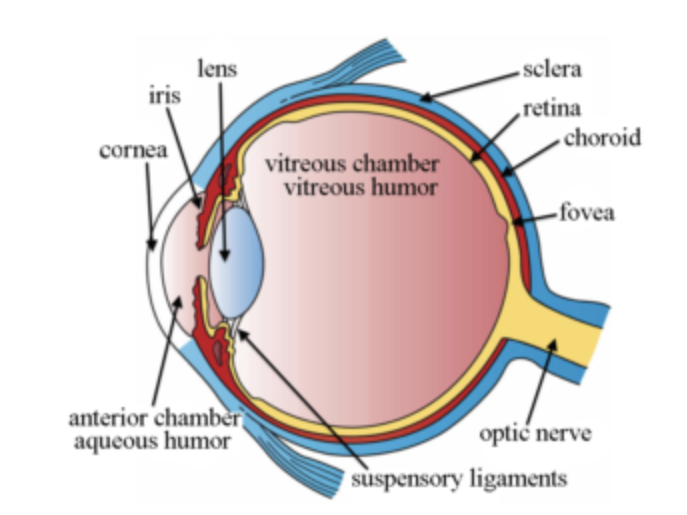
iris
The colored part of the eye that controls the size of the pupil.
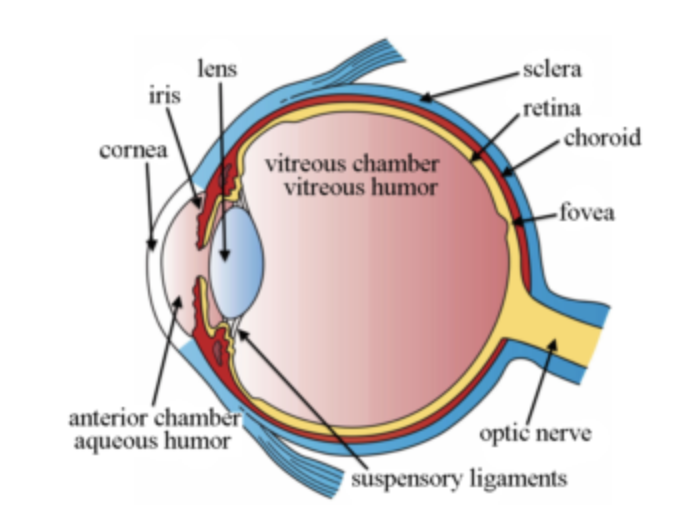
lens
A flexible structure behind the pupil that changes shape to focus light onto the retina (accommodation).
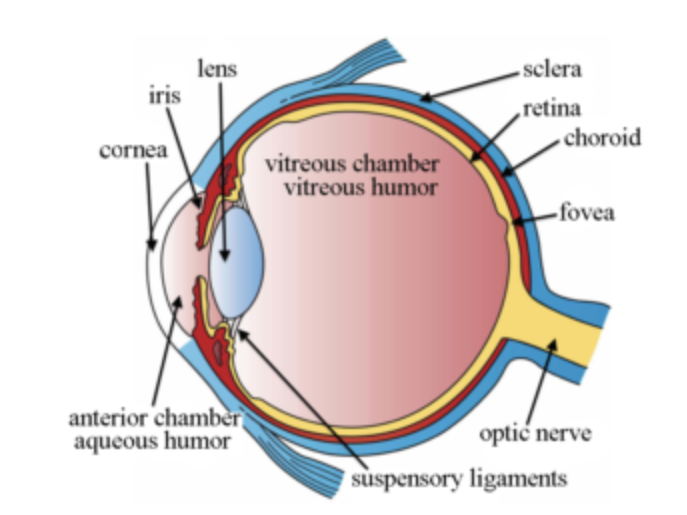
rods
Receptor cells in the retina that detect black, white, and gray, and help with night vision and peripheral vision.
cones
Receptor cells in the retina that detect color and fine details. Work best in bright light.
eye cells
Includes rods, cones, bipolar cells, and ganglion cells. These process visual information before it goes to the brain.
sight goes through the back of the eye all the way through the front and then it goes all the way back to the optic nerve
rods → cones → bipolar cells → ganglion cells → optic nerve
visual pathways
The route visual information travels:
Retina (rods cones bipolar cells ganglion) → Optic Nerve → Optic Chiasm → Thalamus → Visual Cortex (Occipital Lobe)
left visual field
Information from the left side of what you see is processed in the right hemisphere of your brain
right visual field
Information from the right side of what you see is processed in the left hemisphere of your brain.
Dorsal System
dorsal pathway/ where how pathway
tells you where things are and how to physically interact with them (motion, depth, location).
It runs from the occipital lobe (visual cortex) to the parietal lobe.
ex:
When you reach to grab a coffee cup, your eyes detect the cup (ventral stream), but your dorsal stream tells you where it is, how far to reach, and how to move your hand to grab it.
Higher Frequency
Higher frequency means more waves per second,
Higher frequency = shorter wavelength = bluish/purple colors
Higher-frequency light waves produce cooler colors like blue, violet, and purple
Example:
Violet light has a higher frequency than red light.
Lower Frequency
Lower frequency = longer wavelength = red/orange colors
Lower-frequency light waves produce warm colors, like red, orange, and yellow.
Longer wavelengths are at the red end of the visible spectrum.
Example:
Red light has a lower frequency than blue light.
Wavelength/Frequency
Distance between wave peaks; determines color in vision and pitch in hearing.
vision: color
hearing: pitch
Amplitude
Height of a wave; determines brightness (vision) or loudness (hearing).
vision: brightness
hearing: volume
Complexity
when a sound wave is not smooth
In vision, complexity refers to how detailed or layered a visual stimulus is. A stimulus is more complex when it has many shapes, colors, textures, edges, and patterns for the brain to process.
vision: saturation
hearing: timbre
opponent process theory
Color is processed in pairs: red-green, blue-yellow, black-white.
Example: Staring at a red image then seeing a green afterimage.
the young helmholtz trichromatic theory
We see color because we have three types of cones: red, green, and blue.
feature analysis
the process of detecting specific elements in visual input and assembling them into more complex forms
ex: if you hold up your phone, your feature detectors notices every detail of the phone so you know what you’re looking at
perceptual set
A mental expectation that makes us interpret things a certain way.
ex: If you see a blurry shape on the ground while walking at night and you’ve recently watched a scary movie, you might immediately think it’s a snake—when it’s actually just a rope.
accommodation
The lens changes shape to focus near or far objects.
When you're looking at something close, the lens curves (gets thicker) to focus.
When you're looking at something far, the lens flattens to focus.
ex: You're reading a book (close object), then look up to read a street sign far away.
Your eye lens changes shape to help you refocus—this automatic adjustment is accommodation.
photoreceptors
Photoreceptors are specialized cells in the retina of the eye that detect light and convert it into neural signals that the brain can understand.
They are responsible for starting the process of vision.
rods
cones
afterimages
When you stare at a color and then look away, you see its opposite color.
this is the opponent processing theory
monochromatism
Total color blindness—only see shades of gray.
dichromatism
Partial color blindness—missing one color receptor (often red-green colorblind).
feature detectors
Cells in the brain that detect edges, shapes, movement, and faces.
parallel processing
Brain’s ability to process several things at once (color, depth, motion).
blindsight
A condition where people cannot see, but can still respond to visual stimuli.
Example: Can avoid obstacles without consciously seeing them.
prosopagnosia
A disorder where a person cannot recognize faces.
perception = impaired
failure in top down processing
intensity
Amount of energy in a wave, determined by amplitude; affects brightness or loudness.
linear perspective
Linear perspective is a monocular depth cue where parallel lines appear to converge in the distance, giving the illusion of depth and distance on a flat surface.
helps your brain judge depth and distance using one eye
ex: When you look at a long straight road or railroad tracks, they seem to get closer together the farther away they go, even though you know they stay the same width in real life. Your brain uses this cue to understand that the point where they "meet" is farther away.
relative size
Relative size is a monocular depth cue where the brain interprets smaller objects as being farther away and larger objects as being closer, assuming the objects are actually similar in real size.
smaller = farther
ex: If two people are in a photo—one looks much bigger and the other smaller—your brain understands that the smaller-looking person is farther away, not that they are actually tiny.
interposition
Interposition is a monocular depth cue where an object that blocks (overlaps) part of another object is perceived as being closer to you.
objects blocking others are closer
ex: If you see a tree blocking part of a house, you naturally understand that the tree is closer and the house is farther away, even though your eyes aren't measuring distance—your brain is interpreting the overlapping.
relative clarity
monocular depth cue where objects that appear sharper, clearer, or more detailed are perceived as closer, while objects that appear hazy, blurry, or less detailed are perceived as farther away.
This happens because light from distant objects is scattered by particles in the air, making them appear less clear.
hazy objects are farther
ex: When you look at a mountain range, the mountains closest to you look sharp and detailed, while the ones farther away look faded, blurrier, and lighter in color. Your brain uses that difference in clarity to judge depth and distance.
texture gradient
monocular depth cue where objects with detailed, sharp, and distinct textures are perceived as closer, while objects with smooth, fine, or less detailed textures appear farther away.
As distance increases, the texture becomes less clear and more compact, giving the illusion of depth.
closer objects have clearer texture
ex: If you look at a field of flowers or pebbles, the ones nearest to you show clear details, like petals or edges. But as the field stretches into the distance, the textures become blurred and packed together, making those parts look farther away.
retinal disparity
binocular depth cue that uses the slightly different images seen by each eye.
Because your eyes are about 2.5 inches apart, each eye sees the world from a slightly different angle. Your brain compares these two images, and the greater the difference (disparity), the closer the object is.
More disparity = closer object
Less disparity = farther object
ex: Hold your finger in front of your face and look at it—then close one eye, then the other. You’ll notice your finger seems to “jump” from side to side. That shift between the two eye views is retinal disparity, and your brain uses that difference to judge how close your finger is.
convergence
binocular depth cue that occurs when your eyes turn inward (more cross-eyed) to focus on a nearby object. The more your eyes converge, the closer the object is perceived.
Your brain uses the muscle tension in your eye muscles to judge distance.
When an object is close, your eyes turn inward more, and your brain uses that eye muscle tension to perceive depth.
ex: Hold a pencil in front of your nose and slowly move it away. You’ll feel your eyes relaxing outward as it gets farther. That sense of eye strain when it's close is convergence, and your brain interprets it as the pencil being near.
monocular cues
visual signals that allow the brain to perceive depth and distance using only eye
binocular cues
visual signals that rely on the use of both eyes to perceive depth and distance in three dimensional space
phi phenomenon
Lights flashing in sequence look like motion
ex:
Christmas lights blinking in sequence make it look like lights are “running” along the house.
Movie marquees or chasing signs that look like lights are travelling around the border.
In old animations, quickly flashing images create the illusion of movement—this is how motion pictures (movies) work.
Gestalt principle (we perceive whole patterns not just parts)
stroboscopic movement
Still images shown quickly look like motion (animation)
autokinetic effect
Still light in dark room looks like it’s moving
ex: If you stare at a single star in the night sky, it may look like it's slowly moving even though it's not.
apparent movement
Perceiving motion when there is none
phi phenomenon
stroboscopic movement
autokinetic movement
color constancy
The ability to see colors as the same even when lighting changes.
Example:
A red apple still looks red outside in sunlight or inside under dim yellow light.
shape constancy
Perceiving the shape of an object as unchanged even when the angle you view it from changes.
Example:
A door looks like a rectangle whether it’s open, closed, or halfway open—even though its image on your retina changes shape.
visual perception constancy
The overall ability to recognize objects as stable and unchanging even though sensory information (like size, shape, or color on the retina) changes.
This includes:
Size constancy
Shape constancy
Color constancy
Brightness constancy
Example:
A person walking toward you doesn’t look like they’re “growing larger” even though their retinal image gets bigger.
perceptual adaptation
The brain’s ability to adjust to changed sensory input.
Example:
If you wear upside-down goggles, after a while your brain adapts and you start to navigate normally.